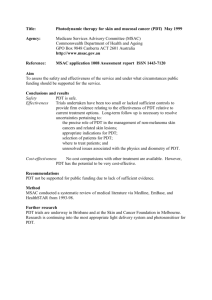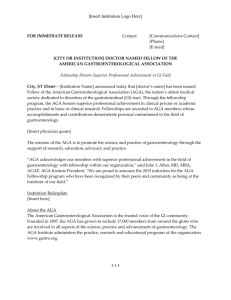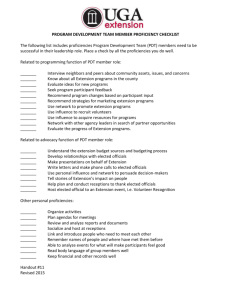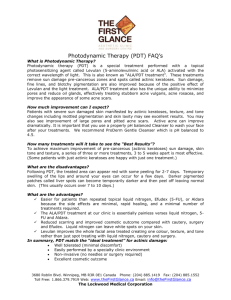Government of Canada (GC) Financial Management Financial
advertisement
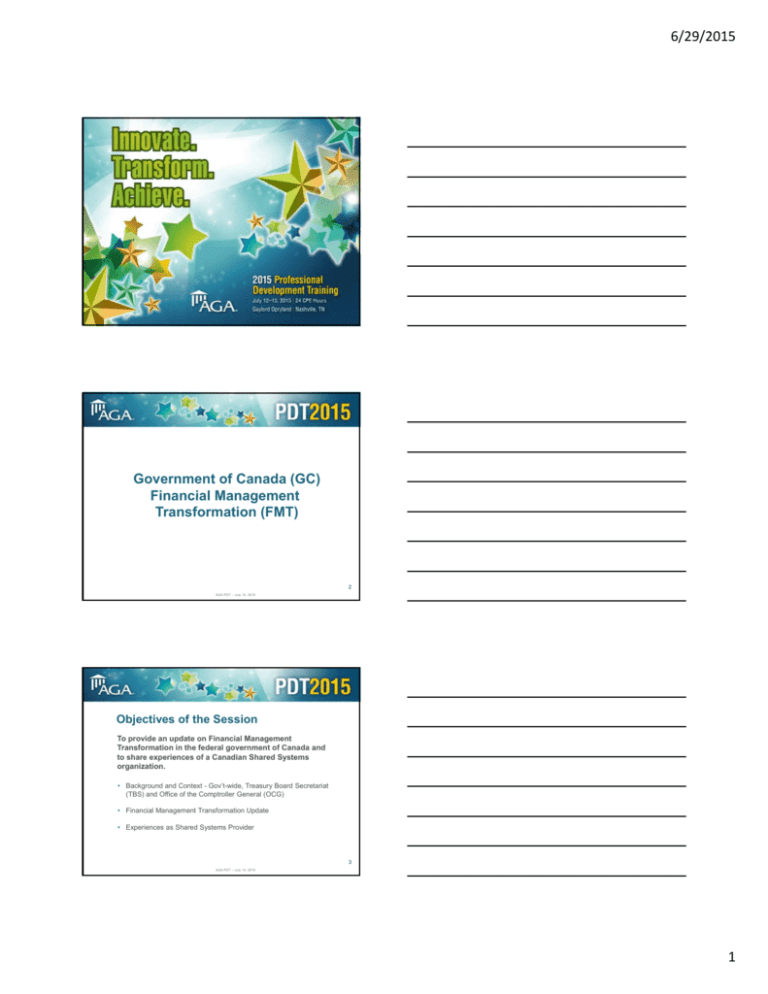
6/29/2015 Government of Canada (GC) Financial Management Transformation (FMT) 2 AGA PDT – July 14, 2015 Objectives of the Session To provide an update on Financial Management Transformation in the federal government of Canada and to share experiences of a Canadian Shared Systems organization. • Background and Context - Gov’t-wide, Treasury Board Secretariat (TBS) and Office of the Comptroller General (OCG) • Financial Management Transformation Update • Experiences as Shared Systems Provider 3 AGA PDT – July 14, 2015 1 6/29/2015 Background – How Government Works • The parliamentary structure in Canada is based largely on the Westminster (British) model. • Government priorities are set out in the Speech From The Throne read at the beginning of each session of Parliament. • Governor General (on the advice of Prime Minister) appoints cabinet members. • Prime Minister issues a “mandate letter” to each Minister setting out priorities for the Minister’s portfolio / department / agency / crown corporation, to guide the Government’s priorities and agenda for each Minister. • Each Department/Agency is led by a non partisan public servant (Deputy Minister) whose mandate is to implement the Government’s agenda. • CFOs are “career” public servants (not politically appointed) 4 AGA PDT – July 14, 2015 Background – Role of the Treasury Board (TB) TB is responsible for the management of government, by translating policies and programs approved by Cabinet into operational reality and by providing departments with resources and administrative environment they need. TB is the General Manager of the public service: • Management Board: promoting improved management performance and approving policies to support the prudent and effective management of the government's assets, financial, information and technology resources. • Budget Office: examining and approving the proposed spending plans of government departments, and reviewing the development of approved programs. • Employer and People Management Office: setting people management policies and managing compensation and labour relations, including determining the terms and conditions of employment. 5 AGA PDT – July 14, 2015 6 AGA PDT – July 14, 2015 2 6/29/2015 Federal Budgets • Over the last few years, the Government has made consistent commitments to transform and renew administrative services including financial management. Budget 2012: made commitments to streamlining, consolidating and standardizing administrative functions and operations within and across organizations. Budget 2013: called for whole-of-government approaches for transforming administrative functions. functions Budget 2014: indicated that achieving leaner and more efficient government is a key part of the government’s plan to return to balanced budgets by 2015. Blueprint 2020 • June 2013, GC launched Blueprint 2020, a dialogue about the future of the Public Service with the goal of ensuring that it remains a world-class institution. Public Servants – in all regions and at all levels across Canada – contributed to the discussion. Called for a “whole-of-government approach.” 7 AGA PDT – July 14, 2015 Back Office Transformation Strategy • Focus on a near term plan, guided by the long term vision. • Phased implementation to manage convergence over time towards the target state enterprise model. • Issue clear direction and timing regarding adoption of mandatory enterprise back office systems (for HR and FM) and services; other areas to follow in the long term term, aligning with the GC service policy. • Gates provide opportunities to adjust direction and pace. Gated/Phased Transformation Continued ministerial oversight and direction Smaller, more productive workforce Today Near-term plan & priorities Target Enterprise Model AGA PDT – July 14, 2015 Fewer, less costly systems More responsive administrative services, reduced business risk, Better information for decision-making 8 Financial Management Transformation FMT’s vison is to evolve and modernize the financial management function across the GC in order to: • Enable CFOs and their organizations to focus on higher-value services to programs and decision makers. • Provide managers and decision-makers with effective, rigorous financial and resource management information, and streamlined financial services. • Enable the Government of Canada to act as one enterprise Target Business Outcomes: 9 AGA PDT – July 14, 2015 3 6/29/2015 Steps to Advance FMT AGA PDT – July 14, 2015 10 11 AGA PDT – July 14, 2015 Next Steps • Understand enterprise and departmental business needs Understand priorities and pain points Validate and define FM functions within target GC FM business model • Further align FM systems-related investments to achieve better value for current or planned expenditures p p and drive standardization • Define a “common financial management language” for government (Target Information Model) as part of Enterprise Information Reporting and Analytics (EIRA) • Enterprise Blueprint for Single FM System Design for enterprise structures (e.g. chart of accounts and master data structures) Provides basis for business process and system configuration standards. • Define Vision and Strategy for FIN and HR integration 12 AGA PDT – July 14, 2015 4 6/29/2015 Central Agency Cluster – Shared Systems • CAC-SS began on April 1st, 1997 as part of the first wave for the GC using the SAP R/3 ERP for Financial and Materiel Management – combined the Department of Finance with Treasury Board Secretariat for a “shared” ERP. First Implementation. • One SAP instance with separate company codes; separate configurations and modules. • Added the Privy Council Office and the Canada School of Public Service in 2004 as part of creating a “Cluster” of Shared Systems. First Cluster. • Relatively stable (450 SAP Users) until the 2012 federal budget which called for a reduction in “back-office” costs. This set off a pathway to change for CAC-SS which ultimately resulted in us becoming part of the FMT programme for change. 13 AGA PDT – July 14, 2015 Why Would CAC-SS be Part of FMT? • The Cluster is providing real and practical information to FMT on the process of on-boarding new Clients to an SAP Cluster – Lessons Learned can be invaluable – both positive and negative. • We have a long long-established established Shared Systems Cluster with employee expertise in many modules of SAP – we can provide practical advice and guidance within an operational context to those creating a new government-wide SAP Instance. • We continue to on-board new clients as much as possible to assist the FMT programme in reducing the Total Cost of Ownership for an important back-end system. 14 AGA PDT – July 14, 2015 CAC-SS – Growth and Change • We are now in our 4th consecutive year of on-boarding new departments so that economies of scale can be harvested with the SAP ERP. • Each project has been different for different reasons and adaptability on both our (Provider) and the Client sides has been key. • April 01, 2013 – on-boarded the Canadian Transportation Agency – small Agency with 200 FTE’s – SAP Users in a Centralized environment. Twist – only 3 months notice – no time for business blueprint or fit-gap – “take what we give you” process. 15 AGA PDT – July 14, 2015 5 6/29/2015 CAC-SS – Growth and Change • April 01, 2014 – on-boarded the Office of the Superintendent of Financial Institutions (600 FTE) and the Immigration Refugee Board (450 FTE). Twists: o OSFI added a second legal entity (Financial Consumer Agency of Canada and significantly changed our Revenue and Costing footprint. o IRB required a specialized Invoicing configuration due to the use of Interpreters for Immigrants. 16 AGA PDT – July 14, 2015 CAC-SS – Growth and Change • April 01, 2015 – on-boarded the Administrative Tribunals Support Service of Canada – 450 FTE. Twists: o 11 Tribunals in 9 different departments using 4 different financial systems – needed to consolidate o First “mid-year” cut-over due to need to close books as one department on March 31, 2015 • April 01, 2016 – Canadian Grain Commission – 450 FTE. Twist – first project for an organization outside Ottawa 17 AGA PDT – July 14, 2015 What Did We Learn? (Rob’s Top 10) • On-boarding is challenging because you not only add numbers, but also changes to processes or footprint – be flexible within a standardization frame-work. Walk the tight-rope between “business” and “systems”. • Costs – will vary but as a general rule, expect to re-invest at least 20% of any new revenue you receive from on-boarding new clients. Staff, consultant time, hardware and software licenses may all increase depending on the depth and breadth of any on-boarding project. Related to this, do not underestimate the resources you need to maintain after on-boarding. This is not a “straight-line” relationship and your overall org structure may change several times. 18 AGA PDT – July 14, 2015 6 6/29/2015 What Did We Learn? • Don’t think “organizationally” when on-boarding. We have found that the best chance of success comes from those organizations with “like” business processes and even cultures if you can. • It’s It s about People – SAP Clustering is not a technology project – it is a business process project – and that means it is a “people” project since people are integral to business processes. We find that giving ourselves at least 3 months of “Phase 0” or time to organize is crucial to beginning the project in the right perspective. You must know the customer and their “orientation” to the project. Manage their expectations from Day One. 19 AGA PDT – July 14, 2015 What Did We Learn? • SAP as a software. Yes it is about business processes but you still have to make a software work. Ensure you look for “gotchas” related to in-year on-boarding for example – watch out for Asset Accounting. Know your software – it is good but it isn’t perfect. • Consultant Support – very few organizations can afford to carry enough staff to maintain a software Cluster and expand it. Keep longterm relationships with consultants if you can. They know your business and can adapt quickly to minor changes in process for specific clients. 20 AGA PDT – July 14, 2015 What Did We Learn? • Governance – regardless of your style of governance, you want to keep your clients once you have them. Be flexible but use a clear and standardized set of “rules of engagement” and Service Levels – problems here can take up far too much time and distract from moving forward Ensure the projects have an engaged and powerful Steering forward. Committee. • New Requirements – these can be killers if you don’t understand what they involve. Example – adding an org that has audited financial statements to a Cluster that does not have this can have a whole “tail” of work to satisfy requirements that you are not used to. Understand new workload before adding clients. You can build it, but can you maintain it? 21 AGA PDT – July 14, 2015 7 6/29/2015 What Did We Learn? • Change Management – do not underestimate this one. It is related to my “people” point earlier but is much broader that just that. SAP forces business process changes, roles and responsibility changes, data and information changes and much more. Have everyone prepared and invest in experts to help you navigate navigate. • Timing – timing is everything! From a go-live of April 1st to make transition easier to ensuring that the first meetings are timed in the calendar year for maximum attendance, this is important. There is enough to do – don’t fight the calendar. 22 AGA PDT – July 14, 2015 Questions? 23 AGA PDT – July 14, 2015 Speakers • Lynn Gibault, CPA A/Director, Financial Management Transformation, Treasury Board Secretariat, Government of Canada y g @ g lynn.gibault@tbs-sct.gc.ca 613-854-7793 • Rob Morrow, MBA, PMP Director, Corporate Financial Systems Treasury Board Secretariat, Government of Canada rob.morrow@tbs-sct.gc.ca 613-995-3606 24 AGA PDT – July 14, 2015 8
